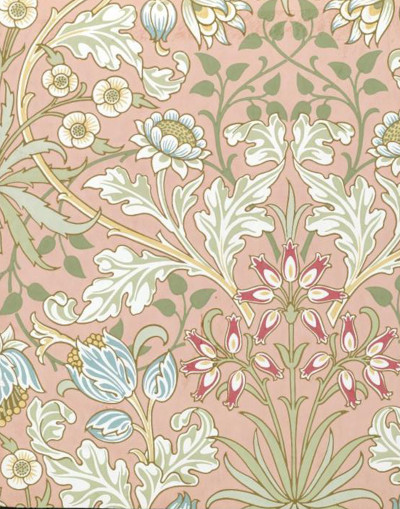This Hyacinth wallpaper is sometimes classified with the pattern code of 480. It may well have been manufactured after William Morris' death, though this was the case with a number of his designs.
There would be considerable work involved in taking one of his designs and preparing it for manufacture. This process could sometimes take several months, if not even longer. Amendments would be made in order to achieve the highest levels of quality possible, and nothing would ever be rushed. Traditional techniques would be used and this helped Morris' company to build up a strong reputation with the field of interior design. His own illustrations could be translated into a wide variety of products, and even after his death new avenues of manufacture were found as tastes changed. It seems his own floral patterns will never fall out of fashion and the art public continue to be drawn to his career which even today feels somewhat contemporary. Hyacinth was one of many flowers tht he incorporated into his work and this design became wallpaper which could be sold all across the country. Morris studied traditional techniques from abroad as well as learning the methods of the UK and would combine the two together with his own themes of nature.
Morris would often find inspriration for content from things in and around his own environment. Some of the flowers that he featured might be growing in his own garden, for example, whilst other local features such as rivers would also be incorporated into some of his designs. Morris was somehow able to create intense displays of nature in ways that could be patterned many times over. He remains regarded as one of the most influentual British artists from the 19th century, certainly within the fields of fabrics, wallpaper and tapestry. Whilst taking influence from abroad, his oeuvre would later inspire new movements to appear outside of the UK and so the path of art history would continue into the next generation. He also highlighted the beauty of the British countryside, with its wild, vibrant nature, as well as the more curated English gardens that provided an alternative experience. He adored both, and worked hard to bring them into the visual arts using traditional artistic methods.
Hyacinth Wallpaper (Pattern #480) provides another example of his floral designs and this creation can be found in wallpaper production. Those interested in botany will find much to appreciate within his art whilst others find these designs to work perfectly in their own homes, either on the wall or as covers for fabric. In the modern era his approach remains highly regarded and many have followed in his footsteps to produce their own take on his patterned designs, potentially drawing in other types of content which is more appropriate to their own lives. He is rightly regarded as a key member of Victorian art and someone who defended the integrity of traditional artistic techniques from right across the world.




